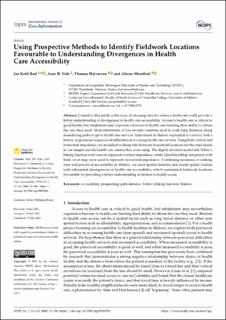| dc.contributor.author | Rød, Jan Ketil | |
| dc.contributor.author | Eide, Arne H. | |
| dc.contributor.author | Halvorsen, Thomas | |
| dc.contributor.author | Munthali, Alister | |
| dc.date.accessioned | 2023-02-13T09:28:25Z | |
| dc.date.available | 2023-02-13T09:28:25Z | |
| dc.date.created | 2021-07-23T22:21:54Z | |
| dc.date.issued | 2021 | |
| dc.identifier.citation | ISPRS International Journal of Geo-Information, 2021, 10, 8, 506. | en_US |
| dc.identifier.issn | 2220-9964 | |
| dc.identifier.uri | https://hdl.handle.net/11250/3050270 | |
| dc.description.abstract | Central to this article is the issue of choosing sites for where a fieldwork could provide a better understanding of divergences in health care accessibility. Access to health care is critical to good health, but inhabitants may experience barriers to health care limiting their ability to obtain the care they need. Most inhabitants of low-income countries need to walk long distances along meandering paths to get to health care services. Individuals in Malawi responded to a survey with a battery of questions on perceived difficulties in accessing health care services. Using both vertical and horizontal impedance, we modelled walking time between household locations for the individuals in our sample and the health care centres they were using. The digital elevation model and Tobler’s hiking function were used to represent vertical impedance, while OpenStreetMap integrated with land cover map were used to represent horizontal impedance. Combining measures of walking time and perceived accessibility in Malawi, we used spatial statistics and found spatial clusters with substantial discrepancies in health care accessibility, which represented fieldwork locations favourable for providing a better understanding of barriers to health access. | en_US |
| dc.language.iso | eng | en_US |
| dc.publisher | MDPI | en_US |
| dc.rights | Navngivelse 4.0 Internasjonal | * |
| dc.rights.uri | http://creativecommons.org/licenses/by/4.0/deed.no | * |
| dc.subject | Malawi | en_US |
| dc.subject | Tobler’s hiking function | en_US |
| dc.subject | path distance | en_US |
| dc.subject | prospecting | en_US |
| dc.subject | accessibility | en_US |
| dc.title | Using prospective methods to identify fieldwork locations favourable to understand divergences in health care accessibility | en_US |
| dc.type | Peer reviewed | en_US |
| dc.type | Journal article | en_US |
| dc.description.version | publishedVersion | en_US |
| dc.rights.holder | Copyright: © 2021 by the authors. Licensee MDPI, Basel, Switzerland. This article is an open access article distributed under the terms and conditions of the Creative Commons Attribution (CC BY) license (https:// creativecommons.org/licenses/by/ 4.0/). | en_US |
| dc.source.pagenumber | 1-17 | en_US |
| dc.source.volume | 10 | en_US |
| dc.source.journal | ISPRS International Journal of Geo-Information | en_US |
| dc.source.issue | 8 | en_US |
| dc.identifier.doi | 10.3390/ijgi10080506 | |
| dc.identifier.cristin | 1922530 | |
| dc.relation.project | Norges forskningsråd: 250815 | en_US |
| cristin.ispublished | true | |
| cristin.fulltext | original | |
| cristin.qualitycode | 1 | |

